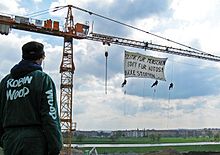Direct action
Direct action is a term from social history and describes the attempt at direct and unmediated intervention in economic and political contexts. No power is delegated to lobbyists, such as parliamentarians or courts: those affected act directly to assert their interests. The achievement of the desired goal must be directly possible through the actions themselves. This distinguishes direct actions from indirect ones such as drafting petitions, collecting declarations of support, founding parties, election campaigns, appeals to rulers, etc. or from retaliatory actions of any kind.
Examples of direct actions are: strikes and general strike , boycott , Critical Mass , demonstration , occupation, construction sites, farms, trees , houses or fields, sabotage , self-organization , gravels , sit-in , smart mob , die-in , Go-In , Teach In.
Concept history
As early as 1907, the French revolutionary syndicalist Émile Pouget worked out “what is meant by direct action” in his work “Die direkt Aktion”:
“Direct action is the symbol of active syndicalism. [...] It means that the working class, in its constant rebellion against the existing order, does not expect anything from outsiders, from external powers or forces, but rather that it creates its own conditions of struggle, draws its means of action from within itself. "
The term was later used in 1920 by William Mellor in his book Direct Action , after Voltairine de Cleyre had already written a text on it and Emma Goldman raised it from the economic to the general level in a work from 1911:
“The direct action, which has already proven successful in the economic field, is equally effective in the field of the individual. Hundreds of compulsions affect its existence there, and only stubborn resistance to it will finally free it. Direct action against management, direct action against the authority of the law, direct action against the intrusive, annoying influence of our moral code is the logical, consistent approach of anarchism. "
In Mellor's definition of industrial action, direct action is the use of an economic power by those who have that power, employers and workers. In addition to lockouts and cartels, he also counts strikes and sabotage among the means . In the Anglo-American area, direct action is also understood as nonviolent action in a radical democratic understanding . Examples are the US civil rights movement and later the nonviolent actions of the peace movement . In groups of the peace movement one also speaks of “nonviolent direct action”.
Direct action and anarchism / anarcho-syndicalism
Direct action is essential as a form of action by autonomists , anarchists and anarcho-syndicalists , which should do justice to the principles of self-organization and non - domination. Since 1968, the term direct action has often been understood to mean all actions that are practical and militant , such as changing election posters and blocking railroad tracks, for example when transporting nuclear waste.
Historically, direct actions are collective, economic actions that - in contrast to negotiations - have a direct effect. Therefore, strikes, boycotts and sabotage are often cited as means of direct action. In the anarcho-syndicalist theory, the general strike is the central direct action. Combined with the appropriation of the means of production by the workers, it represents the social revolution for the anarcho-syndicalists.
In contrast to direct action, propaganda is in fact an individualistic, not necessarily economic, form of action that has historically been used by non-syndicalist anarchists, but also by other political currents, including nationalists. While the direct action should only be a means to an end, the "propaganda of the deed" should serve as a model. Therefore, not only historical assassinations, but also the founding of municipalities and other self-governing structures are to be understood as “propaganda of the deed”. Insofar as the establishment of alternative structures is also intended to fulfill the purpose of securing economic livelihoods, this can also be understood as a "direct action".
See also
- Affinity Group
- Clown army
- Nonviolent Action
- Guerrilla gardening
- Wild strike
- Civil disobedience
- Tree occupation
- Animal liberation
literature
- David Graeber : Direct Action, A Manual. Edition Nautilus, Hamburg 2013. ISBN 978-3894017750 .
- Direct Action Reader. SeitenHieb Verlag , Reiskirchen 2008. ISBN 978-3867470322 .
Web links
- Harald Beyer-Arnesen: Direct action. To understand a concept. (Anarcho-Syndicalist Review, 2000)
- Extensive German-language page on Direct Action with examples, reports and more
Individual evidence
- ↑ Émile Pouget: The direct action. (1907) Anarchist Library.
- ↑ Direct Action by Voltairine De Cleyre (undated)
- ↑ Emma Goldman: Anarchism and Its Real Meaning . "Anarchist texts 11", Libertad Verlag 1983, p. 15


